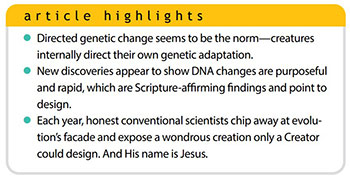
Honesty is good for the soul…especially when the evidence against you is piling up. Some evolutionary biologists held an astoundingly candid conference in Lisbon, Portugal, called On the Nature of Variation: Random, Biased and Directional. The conference’s aim was to provide a context for “critically evaluating the rationale behind” evolutionary assumptions about “variation randomness in the light of new developments.” On center stage for reevaluation was “the underlying assumption supporting adaptationism…that variation is somehow random, namely, that it is neither biased nor directional.” It’s hard to imagine evolutionists seriously asking the questions “Why was variation characterised as random in the first place?” and “How useful is the doctrine of variational randomness? And how should it be characterised?”1
Skeptical questions abound. Two recent papers are titled “What prevents mainstream evolutionists teaching the whole truth about how genomes evolve?”2 and “Who ever thought genetic mutations were random?”3 Likely, most scientists embracing Darwinism would be surprised to know that hundreds of research papers published since the 1970s identify nonrandom “adaptive” or controlled genetic modifications that produce purposeful outcomes. I’ve had discussions with evolutionary biologists who’d never heard of controlled genetic modifications and were disinclined to believe me.
That’s because longstanding evolutionary theory “is based on the tenet that new phenotypes arise through a process relying on the raw material supplied by accidental, numerous, successive, and slight genetic changes.”4 But did a reliable base of scientific evidence ever justify the assertion that most adaptive traits could be attributed to random genetic errors, i.e., “mutations” as commonly understood?
The backstory helps us find the answer. We need to see how nearly everyone is taught to parrot the mantra “mutations occur at random.” This basic creed strongly influences an evolutionist’s thinking—even when staring at contrary evidence. A powerful mental conditioning of successive generations of biologists has virtually ensured that when a genetic change associated with an adaptive trait is observed, it will instinctively be interpreted as an accidentally broken genetic mutation.
Most people absorb this barrage of biased interpretations and also begin intoning “mutations occur at random.” I know that I did. But like everyone else, I was wrong all along. The thought of purposefully directed genetic change wasn’t even in my mind. I didn’t understand why the concept of purposeless genetic accidents is so vital to Darwinism that it has existed akin to an inviolable doctrine for decades.

Questioning Randomness Brings Professional Risks
The evolutionary biologists organizing the Lisbon conference are fully familiar with the mantra “mutations occur at random.” No biology student escapes indoctrination. They’ve heard the sacred confession “mutations occur at random” endlessly repeated in chantlike fashion at conferences and in literature. From their conference description,1 which is well worth the time to read, they knew that presenting evidence for nonrandom genetic change is one thing, but questioning the belief that mutations occur at random could place them out on a limb as Darwinian heretics.
For instance, here’s how orthodox Darwinists are expected to behave. Bacteriologists conducting research on bacteria uncovered that at least some “mutations” were not random. Their conclusive findings were summed up in an article titled “Predictable evolution trumps randomness of mutations.”5 Yet, even as the writer presented contradictory evidence, he still respectfully genuflected to the random mutation creed, saying,
Although mutations, the driver of evolution, occur at random, a study of the bacterium Escherichia coli reveals that nature often finds the same solution to the same problem again and again….The DNA showed that in some cases identical mutations appeared independently in all three test tubes.5
As a bonus, this Darwinist’s scientific explanation for the cause of nonrandom genetic changes was to personify nature as a mystical agent that somehow “finds” identical solutions to biological problems.
That’s why it was shocking, yet refreshingly honest, when the Lisbon conference organizers asked why variation was characterized as random in the first place. But that reveals a remarkable lack of insight that’s widespread in contemporary evolutionary biology regarding why evolutionary theory has been fashioned the way it is today.
Likewise, creationists and Intelligent Design (ID) advocates in general don’t understand how evolutionary theory advances an antidesigner worldview. But we should know why. One of the best ways to identify the specific tenets of evolutionary theory we should target for demolition is to observe what elements knowledgeable evolutionists safeguard at all costs.
The noted evolutionary theorist Stephen J. Gould often castigated colleagues for publishing proposals that recklessly strayed from core Darwinian tenets. He recoiled at flippant suggestions to fundamentally change the theory by associates who “never understood the full logic and implications of this issue” as they proceeded “without grasping the theoretical problems entailed by such excursions” or alternatively failed to grasp a core tenet “which should be emblazoned into the consciousness of all evolutionary biologists.”6 Gould understood how pioneering Darwinists had meticulously crafted essential parts of evolutionary theory so that it could explain the undeniable design of organisms without resorting to God.
Undirected Variation Is Fundamental to Evolutionary Theory
If creatures were static and could not adapt to changing conditions, then a theory of evolution could never get going. But creatures can change. Thus, it is the explanation of adaptation that is steering the direction of the creation-evolution debate. How adaptation happens, it seems, is a question of vital importance.
Here’s a hypothetical mechanism: most biological adaptation happens when highly regulated innate systems direct modifications of genes and traits toward purposeful outcomes. This hypothesis has long been intolerable to most biologists, not because it’s scientifically untenable, but because it’s repugnant to Darwinian philosophy. Why? A hypothesis like this could be associated with words like foresight, purposeful, regulated, directed, or targeted. These words characterize the outcome of engineered systems designed by a rational engineer. Ordinary people might intuitively begin to think the forbidden thought that God engineered creatures to be adaptable.
The anti-theistic power of Darwinism lies in one thing only—its anti-engineering assumptions. Darwin’s key followers developed a model of adaptation that assumes genetic changes are random, accidental, broken, trial-and-error, noncontrolled, and purposeless. That’s why most evolutionary biologists believe that genetic changes are essentially random errors and mistakes, i.e., mutations.7
How are random mutations and anti-theistic thinking linked? If a relentless avalanche of scientific literature can persuade people that organisms really did come about via a chaotic, purposeless process, then this fact would negate God directly creating them, and Darwinism would seem to make more causal sense. Thus, the core of anti-theistic doctrine is spread via a longstanding, non-negotiable tenet of Darwinism: genetic change in adaptation is undirected toward any purposeful outcome.
Gould gives the history behind the anti-design concepts built into Darwinian theory. He summarizes three criteria for genetic variability:
Variation, in short, must be copious, small in extent, and undirected. A full taxonomy of non-Darwinian evolutionary theories may be elaborated by their denial of one or more of these central assumptions.8
He clarifies the meaning of directed variation as “adaptive pressures [that] automatically trigger heritable variation in favored directions.” Gould adds that wholly unbiased variation is fundamental to evolutionary theory. “In a sense, the specter of directed variability threatens Darwinism” in the most serious way. Why? Because automatic responses sound like the outcomes of elements corresponding to human-engineered systems. Thus, “Darwin clearly understood the threat of directed variability to his cardinal postulate of creativity for natural selection.”8
The Lisbon conference organizers underscored the lethality of directed genetic change to the anti-design purpose of evolutionary theory, saying,
Futuyma (2005, p. 179) makes the same point by invoking the spectre of Lamarckism: “The argument that adaptively directed mutation does not occur is one of the fundamental tenets of modern evolutionary theory. If it did occur, it would introduce a Lamarckian element [nonrandom, useful changes to traits in response to changing conditions] into evolution, for organisms would then acquire adaptive hereditary characteristics in response to their environment.”9
After presenting evidence for nonrandom genetic change, they added that Futuyma only makes “reference to theoretical reasons for dismissing the possibility that mechanisms of directional mutagenesis might exist.”10
It’s remarkable that well-informed Darwinists like Gould and Futuyma see nonrandom, directed genetic change as a nightmare (i.e.,“a specter”) to evolutionary theory. Perhaps creationists and ID advocates should be investing focused effort to make the nightmare come true.

Abundant Evidence of Nonrandom Genetic Change
Likely no one disputes that copying errors and truly random mutations happen. But there’s always been an absence of direct evidence that all mutations, especially genetic changes associated with suitable adaptations to environmental challenges, are fully random. By the 1980s, contrary findings made one researcher ask, “The great primary problem is evidently set by the mutations. Are they random or nonrandom?”11
Today, James Shapiro, another evolutionist, assembles evidence for nonrandom “natural genetic engineering” in Evolution: A View from the 21st Century. A reviewer notes that Shapiro “rejects this [random mutation] view by taking into account an extraordinary amount of molecular evidence (the book’s impressive bibliography refers to over 1,100 research articles).”12
There’s a growing body of evidence that many mutations are not random in their formation.13 In fact, many genetic changes seem to be specially programmed as targeted responses to specific external conditions. When cells detect different environmental conditions, innate mechanisms that are currently not well understood can change their chromosome state and alter the patterns of chemical tags on DNA.14 Adaptive responses in bacteria can result from the same independently occurring genetic change in different populations.15 Short segments of DNA can be inverted to generate new patterns in human chromosomes.16
Work on yeast exposed to toxins found that they seemed to be directing greater genetic variation to the exact location to produce protective traits and provide “cells with a remarkable and unexpected ability to alter their own genome in response to the environment.”17 Intracellular enzymes may control the location of genetic changes on chromosomes in humans.18 Recent research on genetic changes in the plant Arabidopsis thaliana “found a lower mutation frequency inside gene bodies and certain essential genes, shattering the long-standing idea that mutations are entirely random across the genome.”19
This is just a foretaste. Two researchers summarize what they and others have found:
But this view [random mutation] is being revised by discoveries of molecular mechanisms….These mechanisms reveal a picture of highly regulated mutagenesis, up-regulated temporally by stress responses and activated when cells/organisms are maladapted to their environments—when stressed—potentially accelerating adaptation. Mutation is also nonrandom in genomic space, with multiple simultaneous mutations falling in local clusters, which may allow concerted evolution….Assumptions about the constant, gradual, clock-like, and environmentally blind nature of mutation are ready for retirement.20

Taking Aim at the Dogma “Mutations Occur at Random”
Fortunately, we’re at a unique time in biological research where a flood of discoveries identifies many apparently nonrandom ways that DNA is changed. This also makes theological sense. The belief in a chaotic mechanism for adaptation is inconsistent with all the other incredibly complex and purposeful biological systems the Lord Jesus created. In this and future Acts & Facts issues, the ICR science staff will be honoring the Lord Jesus by highlighting nonrandom mechanisms for adaptation.
References
- On the Nature of Variation: Random, Biased and Directional, a CFCUL/BIODECON International Conference held October 3-4, 2017, at the University of Lisbon.
- Shapiro, J. and D. Noble. 2021. What prevents mainstream evolutionists teaching the whole truth about how genomes evolve? Progress in Biophysics and Molecular Biology.165: 140-152.
- Veitia, R. A. 2022. Who ever thought genetic mutations were random? Trends in Plant Science.27 (8): 733-735.
- Vecchi, D. 2013. The Trouble with Natural Genetic Engineering: James A. Shapiro: Evolution: A View from the 21st Century. Biological Theory. 7 (1): 80-88.
- Laursen, L. Predictable evolution trumps randomness of mutations. Nature. Posted on nature.com February 19, 2013.
- Gould, S. J. 2002. The Structure of Evolutionary Theory. Cambridge, MA: Belknap Press of Harvard University Press, 544-545 and 251.
- The word mutation technically means any change to a genetic sequence resulting from any cause. Thus, a purposefully directed genetic change would still be called a mutation. The overwhelming usage of the word mutation in technical literature refers to a genetic change interpreted to be a purposeless error or broken gene. Since a definitive test to show that a genetic change is either a mistake or purposeful doesn’t exist, ICR researchers prefer not to mislead readers and instead use the non-stigmatizing term “genetic change” instead of “mutation,” unless the genetic change is unambiguously linked to debility or disease.
- Gould, Structure of Evolutionary Theory, 145. Emphasis added.
- On the Nature of Variation: Random, Biased and Directional. Emphasis added. Quotation drawn from Futuyma, D. J. 2005. Evolution. Sunderland, MA: Sinauer Associates.
- Ibid, emphasis in original.
- Brundin, L. Z. 1986. Evolution by Orderly Stepwise Subordination and Largely Nonrandom Mutations. Systematic Biology. 35 (4): 602-607.
- Vecchi, The Trouble with Natural Genetic Engineering.
- Hogeweg, P. 2015. Non-Random Random Mutations: A Signature of Evolution of Evolution (EVOEVO). Proceedings of the European Conference on Artificial Life 2015, 1.
- Zhu, J. et al. 2013. Genome-wide Chromatin State Transitions Associated with Developmental and Environmental Cues. Cell. 152 (3): 642-654.
- Herron, M. D. and M. Doebeli. 2013. Parallel Evolutionary Dynamics of Adaptive Diversification in Escherichia coli. PLoS Biology. 11 (2): e1001490.
- Löytynoja, A. and N. Goldman. 2017. Short template switch events explain mutation clusters in the human genome. Genome Research. 27 (6): 1039-1049.
- Hull, R. M. et al. 2017. Environmental change drives accelerated adaptation through stimulated copy number variation. PLoS Biology. 15 (6): e2001333.
- Pinto, Y. et al. 2016. Clustered Mutations in Hominid Genome Evolution are Consistent with APOBEC3G Enzymatic Activity. Genome Research. 26 (5): 579-587. 19. Veitia, Who ever thought genetic mutations were random?
- Fitzgerald, D. M. and S. M. Rosenberg. 2019. What is mutation? A chapter in the series: How microbes “jeopardize” the modern synthesis. PLoS Genetics. 15 (4): e1007995.
*Dr. Guliuzza is President of the Institute for Creation Research. He earned his Doctor of Medicine from the University of Minnesota, his Master of Public Health from Harvard University, and served in the U.S. Air Force as 28th Bomb Wing Flight Surgeon and Chief of Aerospace Medicine. Dr. Guliuzza is also a registered Professional Engineer and holds a B.A. in theology from Moody Bible Institute.




















